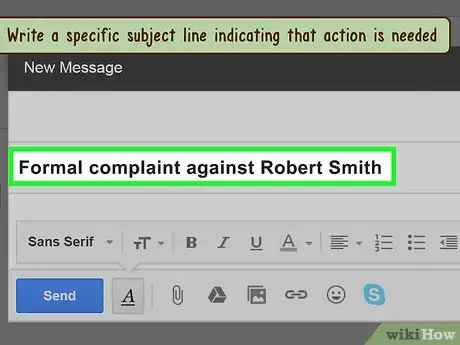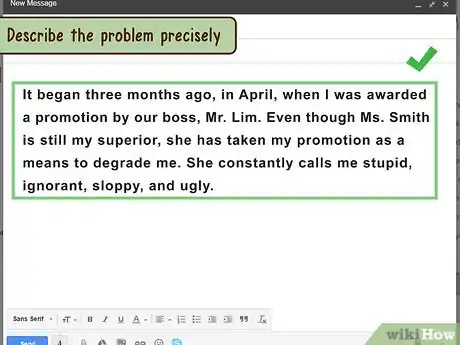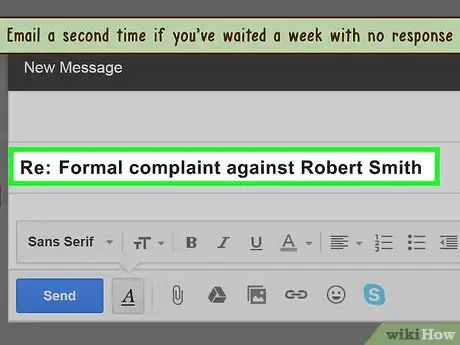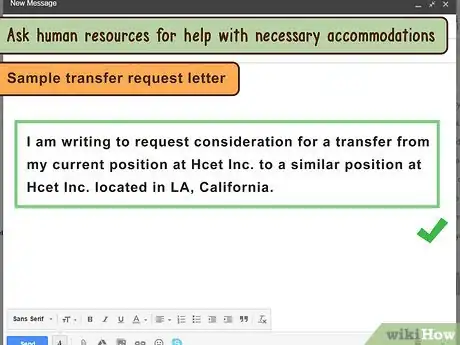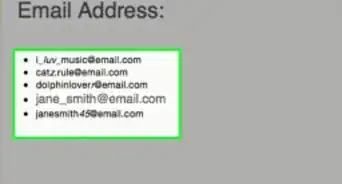This article was co-authored by Gina D'Amore. Gina D'Amore is a Financial Accountant and the Founder of Love's Accounting. With 12 years of experience, Gina specializes in working with smaller companies in every area of accounting, including economics and human resources. She holds a Bachelor's Degree in Economics from Manhattanville College and a Bookkeeping Certificate from MiraCosta College.
There are 12 references cited in this article, which can be found at the bottom of the page.
This article has been viewed 252,072 times.
Businesses employ human resources professionals to handle everything from payroll and policy issues to legal grievances. If you have a legal or policy question, or a serious problem with one of your co-workers, you may need to contact a representative in the human resources department. Human resources may also be the first department you contact at a particular company. It’s a good idea to start this conversation with a simple, formal email introducing the person to your specific problem.
Steps
Writing and Sending the Email
-
1Address your email to the proper person. Check the human resources directory and see if there’s a person assigned to handle the type of problem you need addressed. There may also be a point of contact assigned to your department in the company. If you’re concerned about your issue being taken seriously, you can also reach out directly to the head of human resources.
- Double check that only the person you want to contact is addressed in the email. Especially if this is a private or sensitive issue, you don’t want to send it to the wrong person by accident. Be especially careful to remove any lists that would send the email to a set group of employees.
-
2Write a specific subject line indicating that action is needed. A clear subject line communicating both your problem and the level of urgency you’re assigning to it will help human resources prioritize your problem. If you leave this line blank or unclear, your correspondence may get buried in someone’s inbox.[1]
- Use lines such as: “Legal Problem - Action Required,” “Personal Circumstances Changing - Immediate Attention Needed,” “Urgent Policy Question,” or “Recent Interview - Thank You.”
Advertisement -
3Use formal salutations at the beginning and end of your email. You want to set a formal and professional tone early on in this conversation. This will help human resources know that you’re treating the issue seriously. Even if you know the representative personally, remember that this is a professional, rather than just a friendly, discussion.[2]
- Start with “Dear [full name of the representative]” and end with “Sincerely” or "Best regards" or “Thank you for your time, [Your full name].”
- It's also a good idea to end the email with "Thank you for your time."
-
4Write clear, direct, and specific content. Keep your sentences short and to the point. Don’t provide more information than is necessary, as you don’t want the reader to get bogged down in the email. Don’t include any details that could confuse human resources about your issue. You can address complicated details in person.[3]
-
5Describe the problem precisely. Explain the exact nature of your problem. Provide a timeline of when the issue started, or will start. Clarify whether you think this is a legal problem or an issue that can handled by the company itself.[4]
- If you’re contacting human resources to ask about job opportunities, you won’t be introducing a problem. Rather, introduce yourself, and explain your past contact with the company. Be clear about what actions you expect or would like the representative to take.
-
6Note whether you have documentation of your problem. Human resources will want to know right away how to address legal or policy problems. Your documentation may affect their response, as it will help clarify both the seriousness of the issue and the legal repercussions a particular employee may be facing. Make your representative aware of any and all “proof” you have in your possession, and offer to bring it to an in-person meeting.
- If possible, you’ll want proof of any legal problems to present to human resources. Unfortunately, most human resources departments will try to protect the company if they can.[5]
- If you’re experiencing harassment or discrimination, keep a record of the dates of the incidents and save any written correspondence that includes incriminating language.
- Retain both electronic and paper copies of any documentation you provide to human resources. You should keep the original, and provide human resources with copies.
-
7Explain what you’ve done to address the problem. You may have already tried to solve the issue before you contacted human resources. Perhaps you had a conversation with your boss or co-worker, or even notified them that you’d be contacting human resources. The representative will appreciate having this information, as it will help them understand who’s already aware of the problem.[6]
- For issues of changing personal circumstances, this communication may feel less formal. If you’re going on maternity or paternity leave, for example, you’ve likely already informed your boss of your status and are simply following through with human resources.
-
8Ask for an in-person meeting. A meeting where you sit face-to-face with your representative will help you discuss the problem in detail. This will provide the representative with the opportunity to ask any follow-up or clarification questions. Your email is the perfect place to begin scheduling that critical meeting. Inform them of blocks in your schedule, and ask them to plan accordingly.[7]
-
9Be sure your contact information is included. Human resources may want to contact you via phone, so include several methods of contact at the bottom of the email. This information can go directly below your name after you sign off from the correspondence. Double check the accuracy of the phone numbers and emails you’ve provided.[8]
-
10Edit your email for typos, spelling, and grammar mistakes. Most email services have a spell-check service. Next, read through your email to catch grammatical mistakes, missing words, and issues of clarity.[9]
Following up on a Sent Email
-
1Thank human resources for any response they send. First, thank the representative for taking the time to look into your case, as this will immediately set a tone of courtesy in your conversation. Be sure to reply to any response human resources sends quickly. This will indicate that you remain concerned about the problem, and it should also communicate your desire to address it sooner rather than later.
-
2Organize any necessary materials for your in-person meeting. Prepare yourself for the meeting by creating a special file folder containing any documents you plan to bring. If you have a policy question, bring the employee handbook with the specific policies bookmarked. This will help the meeting run smoothly once you arrive.[10]
-
3Consider hiring legal counsel if you’re bringing up legal issues. If you’re worried about protecting yourself from any actions the company may take against you, talk to a lawyer. They can provide you with information about your rights, and you may decide to bring them to any in-person meetings. You might want to inform human resources of your plans to employ a lawyer if you choose to go this route.[11]
- Be sure you’re aware of the costs associated with hiring a lawyer. Most will be costly, so you’ll need to weigh these budgetary concerns with your need for legal protection.
-
4Email a second time if you’ve waited a week with no response. A week is generally considered an appropriate amount of time to wait before sending a follow-up email. If you’re dealing with an especially urgent problem, you can send a follow-up after 24 hours. Rather than worrying that you’re nagging your representative, remember that they have many responsibilities. They may need a reminder that you’re one of them.[12]
Deciding Whether to Contact HR
-
1Solve the problem on your own if you can. If you have a simple and non-legal issue that doesn’t relate to company policy, you may be able to address it on your own. If possible, discuss the problem with your boss or co-workers to troubleshoot the issue with them. Human resources will appreciate knowing any steps you took to find a solution before coming to them.[13]
- If, for example, you feel your boss is scheduling you for too many weekends, talk to your boss first. You also don’t want to go to human resources with a non-critical complaint like “I don’t like my office space.”
-
2Review your employee handbook to check on your company’s policies. You may feel that you’re experiencing a violation of company policy. Before you contact human resources, re-read the specific policies having to do with your problem. You’ll want to be able to cite those examples in any discussions you have with human resources.[14]
- For example, if you’re concerned you’re not receiving enough breaks during work hours, check the written rules on break times. It’s possible that your company only has an informal, rather than codified, break policy, which means that human resources can’t do much to help you in an official capacity.
-
3Contact human resources immediately if you’re being harassed at work. Do not hesitate to reach out if you’re experiencing any kind of verbal, physical, or sexual harassment from any source at work. You are legally protected from this kind of behavior, and human resources is obligated to help and protect you.[15]
- Do not expect that human resources can have off-the-record conversations about these issues, however. Once you report it, they are required to act.
-
4Contact human resources if your personal circumstances are changing. Human resources can help you plan for any upcoming changes in your work situation, such as if you’re getting ready to take maternity leave. They’ll be able to ensure you receive all your benefits and coverage. They can also contact people at the company who need to be made aware of your changing circumstances.[16]
-
5Contact human resources if you need government protection. Certain situations may arise at work that entitle you to protection or compensation from the government. If, for example, you’re injured on the job, human resources can help you coordinate coverage of your medical expenses.[17]
- This will likely require you to fill out paperwork with human resources, so be prepared for this process.
-
6Contact human resources if you want access to job training. There may be training or mentorship programs available that would allow you to advance in your company. Human resources can provide you with any necessary information about these options and possibly coordinate your entrance into these programs. This could be a great opportunity to take your career to the next level.[18]
-
7Ask human resources for help with necessary accommodations. Human resources can also help you address any individual needs you may have at work. Your work environment should include resources that allow you to enjoy the same opportunities to succeed as any other employee.[19]
- If you feel that there aren’t appropriate disabled resources, for example, human resources will address this problem. The department can also work with you to ensure there’s a designated place for nursing mothers.
-
8Reach out to human resources if you’re looking for a job. Occasionally, contacting a human resources representative at a particular company can allow you to receive information about current job openings or opportunities for informal, “informational” interviews with current employees. You can also contact human resources to say thank you for a recent interview you completed with their company.[20]
- If you don’t receive a reply after a week, you can send one follow-up email. After that, you may need to let this company go.[21]
-
9Avoid contacting human resources with personal grievances. Remember that human resources works for the company first, so they’re not the people to go to if you just want to vent. While you absolutely shouldn’t avoid reporting any situations that make you feel uncomfortable or discriminated against, be careful to distinguish between issues that might simply be annoying or petty and more serious, legal problems.[22]
Community Q&A
-
QuestionCan you provide an example of an email to human resource?
 Community AnswerWhile there are a variety of problems that you may need to raise with human resources, this sample letter can provide you with a good template of how one person addressed discrimination in the workplace. The letter format can be translated to email.
Community AnswerWhile there are a variety of problems that you may need to raise with human resources, this sample letter can provide you with a good template of how one person addressed discrimination in the workplace. The letter format can be translated to email. -
QuestionShould I mention the person by name who wasn't punished for the issue I'm reporting?
 Community AnswerYou'll have to make this decision on your own, and it will depend what kind of consequences you want the person to experience. If they've violated the law or the company's policies, they may be fired if you mention them by name. However, this may be appropriate, depending on their action.
Community AnswerYou'll have to make this decision on your own, and it will depend what kind of consequences you want the person to experience. If they've violated the law or the company's policies, they may be fired if you mention them by name. However, this may be appropriate, depending on their action. -
QuestionHow can I email my human resources department to ask for a raise?
 Community AnswerYou should probably include both your manager and human resources in any conversations about potential raises, so cc your boss on your email. You'll also want to time the conversation correctly. If you've just received poor feedback, it may not be the best time to ask. Finally, be sure you've done your research. If you ask for a salary hike that doesn't match up to what other employees at similar levels and in similar positions are paid, you may not get a good response.
Community AnswerYou should probably include both your manager and human resources in any conversations about potential raises, so cc your boss on your email. You'll also want to time the conversation correctly. If you've just received poor feedback, it may not be the best time to ask. Finally, be sure you've done your research. If you ask for a salary hike that doesn't match up to what other employees at similar levels and in similar positions are paid, you may not get a good response.
References
- ↑ https://www.thoughtco.com/how-to-write-a-professional-email-1690524
- ↑ https://englishlive.ef.com/blog/write-perfect-professional-email-english-5-steps/
- ↑ https://www.menlo.edu/wp-content/uploads/2015/03/writing-a-formal-email.pdf
- ↑ https://www.citizensadvice.org.uk/work/problems-at-work/Letter-to-raise-a-grievance-at-work/
- ↑ http://www.talentzoo.com/news/When-Do-I-Take-a-Work-Issue-to-HR/18029.html
- ↑ https://www.citizensadvice.org.uk/work/problems-at-work/Letter-to-raise-a-grievance-at-work/
- ↑ http://www.acas.org.uk/?articleid=1670
- ↑ https://www.menlo.edu/wp-content/uploads/2015/03/writing-a-formal-email.pdf
- ↑ https://www.menlo.edu/wp-content/uploads/2015/03/writing-a-formal-email.pdf
- ↑ http://www.talentzoo.com/news/When-Do-I-Take-a-Work-Issue-to-HR/18029.html
- ↑ https://www.spigglelaw.com/employment-blog/surviving-workplace-investigations/#
- ↑ http://careersidekick.com/follow-up-after-interview-no-response/
- ↑ http://money.usnews.com/money/blogs/outside-voices-careers/2015/10/05/4-times-you-should-talk-to-hr-and-a-bunch-of-times-when-you-shouldnt
- ↑ http://www.talentzoo.com/news/When-Do-I-Take-a-Work-Issue-to-HR/18029.html
- ↑ http://www.cbsnews.com/news/when-your-hr-department-is-your-friend/
- ↑ http://www.cbsnews.com/news/when-your-hr-department-is-your-friend/
- ↑ http://www.cbsnews.com/news/when-your-hr-department-is-your-friend/
- ↑ http://theundercoverrecruiter.com/when-should-you-go-human-resources/
- ↑ http://www.talentzoo.com/news/When-Do-I-Take-a-Work-Issue-to-HR/18029.html
- ↑ http://idealistcareers.org/13-helpful-email-templates-to-use-while-job-searching/
- ↑ http://careersidekick.com/follow-up-after-interview-no-response/
- ↑ http://www.cbsnews.com/news/when-your-hr-department-is-your-friend/

